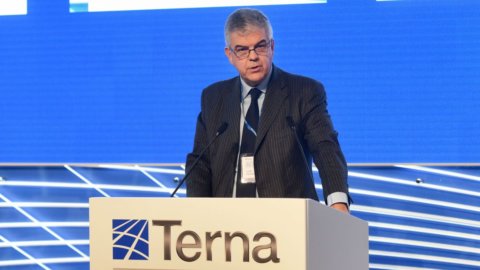Investments, sustainability and dividends, with the grid placed at the center of the national energy transition. These are the three key points of the 2018-22 five-year strategic plan presented today in Milan by Terna, which is divided into five pillars: domestic networks, to strengthen which investments will be 5,3 billion, up 30% on the previous plan; non-regulated activities and the development of optical fiber; international operations, with South America and in particular Brazil at the center of the business; the consolidation of the financial structure through profit and Ebitda growth targets; and the dividend policy, which will have an average annual growth (CAGR) of 6% until 2020 compared to 2017, to then settle on a 75% payout in the last two years of the plan, with a minimum guaranteed dividend equal to that of 2020.
"70% of the investments will be sustainable: they will solve congestion, improve the quality of services as well as the environmental and visual impact", he said at the conference Terna's CEO Luigi Ferraris, recalling that the three macro guidelines for the future of energy in the global panorama are those dictated by COP21, European rules and in Italy by Sen: "Europe is at the top for energy investments and Italy in 2016 produced already, including hydroelectric, 38% of energy from renewable sources, second country after Spain. However, climate change requires that for every euro invested in renewables, there is one euro invested in the grid, to ensure that it is safe and resilient".
GLOBAL SCENARIO
The indications of the United Nations (COP21), the EU guidelines (Clean Energy Package) and the guidelines of the National Energy Strategy (SEN) converge towards a system that in the coming years will necessarily have to be sustainable, de-carbonised and increasingly characterized by the diffusion and the availability of energy from renewable sources. The targets set by the SEN envisage the achievement of a 28% share of renewable sources on total consumption by 2030 (a value that reaches up to 55% in electricity), the complete phase-out of coal by 2025, greater interconnections with foreign countries and a storage potential of 5 GW. In this context, electricity grids assume a central and even more strategic role than in the past.
In fact, transmission grid operators such as Terna will play a central role in this context of great energy change at a global level: this is confirmed by the 6.700 billion dollars of investments foreseen by the International Energy Agency for the electricity sector by 2025, linked mainly to generation from renewable sources and grid infrastructures: in practice, for every euro invested in the development of renewables will correspond to one euro invested in electricity grids. These investments will make it possible to create an increasingly interconnected and technologically advanced electricity system to optimize the management of flows, as well as being sustainable from the point of view of the construction of the works and the relationship with the territories involved.
INVESTMENTS
Strengthening the domestic transmission grid is therefore, as never before, at the heart of Terna's efforts over the next 5 years. In fact, of the 5,3 billion investments in Italy, approximately 2,8 billion euros will be dedicated to the development of the national electricity grid with interventions to increase interconnections with foreign countries, strengthen the connections between market areas and rationalize the networks in the main metropolitan areas of the country. Specifically between international interconnections, projects that put Italy at the center of the northern continental, Balkan and Euro-Mediterranean system, with the aim of increasing cross-border exchange capacity, facilitating the progressive integration of markets at a continental level, include those with France and Montenegro, which is expected to be completed by the end of 2019, and the start of work on the new SA.CO.I.3 project (connecting Sardinia, Corsica and the Italian peninsula).
About 700 million are instead destined for defense plan. In fact, Terna envisages the construction and installation of devices to increase the security and stability of the system and the further development of its fiber optic network with a targeted plan for new laying. Finally, approximately 1,9 billion euros will be dedicated to renewal and efficiency activities, mainly for the improvement of the quality of the service and for the integration of the electricity grid acquired at the end of 2015 from the FSI group. As regards non-regulated activities, Terna will consolidate its role as “Energy solution provider”, developing services for businesses and seizing market opportunities with high added value for traditional and renewable customers. In the telecommunications sector, business will be directed towards pursuing opportunities based on the valorisation of the group's infrastructures.
INNOVATION AND DIGITALIZATION
Terna will dedicate approximately 600 million euros to the development of innovative solutions to deal with the growing complexity of the system: investing in digitization is essential for managing electricity flows on the grid in a safe, efficient and reliable way, also given the need to compensate variability of demand and, above all, generation from intermittent renewable sources. In addition to the aforementioned fiber optic laying plan, new digital systems for remote control and diagnostics of power stations will be introduced.
FINANCIAL TARGETS AND DIVIDENDS
Among the other objectives of the plan, Terna envisages a increase in revenues to approximately 2,55 billion euros and EBITDA to 1,9 billion euros in 2022, with an average annual growth of over 3% for both indicators since last year. Net profit is also improving, with an average annual growth of around 3%, which will lead to earnings per share of around 38 euro cents in 2022. With these results, an operating cash flow of 6,3 billion euro will be guaranteed. euro over the period of the plan, which will contribute to the flexibility necessary to carry out the planned investments while supporting an attractive dividend policy. Terna's financial structure will remain solid with a net debt/rab ratio that will remain below 60% over the five-year period. The value of regulated assets (RAB) will reach 17,5 billion euros in 2022, with a CAGR above 3%.
The new dividend policy will have a five-year span and, as mentioned, will be increasingly generous: from 2018 to 2020 a dividend per share is expected with an average annual growth (CAGR) of 6% compared to the dividend pertaining to 2017. for the years 2021 and 2022, a payout of 75% is expected, with a guaranteed minimum dividend equal to the dividend pertaining to the 2020 financial year. The 2017 financial year closes with a proposed dividend of 442.198.240 euro, equal to 22 cents of euros per share.
BUDGET 2017
Terna closed 2017 with a net profit of 688,3 million euros, an increase of 8,7% compared to 633,1 million in 2017. Revenues reached 2,248 billion euros (+6,9%) , EBITDA 1,603 billion (+3,8%), EBIT 1,077 billion (+4%). Net financial expenses for the year, amounting to 88,8 million, decreased by 14 million compared to 102,8 million in 2016, due to the refinancing of debt at more competitive rates during the year.
The consolidated balance sheet as at 31 December 2017 showed a shareholders' equity equal to 3,803 billion compared to 3,535 billion in 2016 and, despite total investments of 1,034 billion, up 21%, net financial debt fell to 7,796 billion, -179,9 million compared to 7,976 billion at the end of the previous year, thanks to good cash generation in the period . Terna's board of directors will therefore propose to the shareholders' meeting the approval of a total dividend for the 2017 financial year of 442.198.240 euros, equal to 22 euro cents per share, of which 7,4263 euro cents already paid as an advance and 14,5737 .XNUMX euro cents as the balance in June of this year.
''2017 was a very positive year for the Group, with growing results in all the main economic and financial indicators - commented the CEO Luigi Ferraris - This made it possible to recognize a growing 2017 dividend to shareholders. These numbers, together with the significant acceleration in investments, which grew by 21% compared to 2016, are the basis of the 2018-2022 Strategic Plan which will accompany the country towards a full energy transformation. The goal is a complete integration of renewables and digitization of the infrastructure for greater safety and resilience, to the benefit of the entire system. The ambitious objectives, which we have set ourselves for the future - specified Ferraris - and which we intend to respect, allow us to guarantee all our shareholders a generous dividend policy, increasing compared to the previous plan to guarantee a safe and predictable return on investment''.





